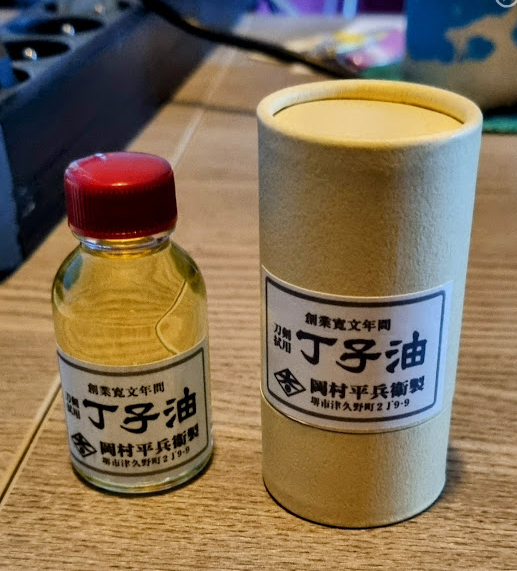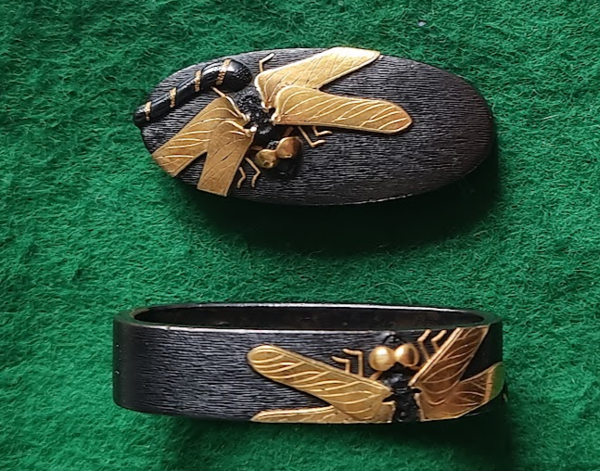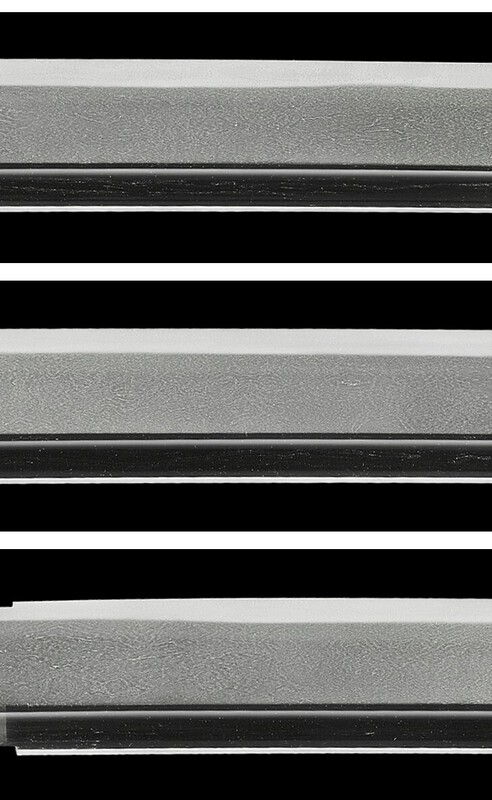-
Posts
1,082 -
Joined
-
Last visited
-
Days Won
5
Everything posted by DirkO
-
Again, I've never had issues importing tsuba. 2 purchases in December arrived without any problem. I stated harmonized tariff 9706 as usual and also paid the reduced import fee (6% or 9%, I always forget which one it is). Currently have another one in transit, should arrive in a week or so after the usual delay.
-
About collecting in this field I think this is a must read (by Guido Schiller): Collecting.pdf
-
Tetsugendo Naomichi used different kanji (尚道)
-
According to the signature 政長 , several options: - Kikuchi school - Tsuji school - Yasuda school Yasuda (安田) school seems improbable - they usually applied nanako and almost never signed their work, also working for the bakufu their designs tend to be more formal. Kikuchi (菊池) school or Tsuji (辻) school - could be any of these looking at the style and design.
-
on the other hand - you need to reply - otherwise these statements go unchecked! Context needs to be provided.
-
Wouldn't the people be shown on the roads then and not beside them? I like the idea though.
-
-
Sorry Dan, all those recesses are part of the original design. This is a very common way to create a dynamic and depth into the design. Which also explains the zogan. If you like it, that's great! But don't try to make in something that it's not.
-
Can I first say I like this open discussion idea of yours? You're trying to create a new division of tsuba based on current knowledge. Which is exactly what the people in the past did as well. But obviously they had far less material to go on and were bound by tradition. Regarding your fixation on Akiyama, I suggest you read Sasano's Japanese Swordguard Masterpieces. He actually goes into the current nomenclature of schools and where they originated from. eg Kyo-sukashi were first mentioned in "Honpo Token Koh" (1795) which references an even older publication "Muromachi-Kaki" - a publication that Sasano doubt ever existed. So he was very diligent and critical about how the naming of schools came to be. This is just one example, the other schools are handled in an equal way. In the Toso Tosogu Shogaku Kyoshitsu (NBTHK published - translated by Markus Sesko), Fukushi Shigeo goes even further in dept on the origin of the naming of each school in his typical Q&A fashion. He usually describes what was believed in the past, what's the current view and how they arrived at that and even the uncertainties that still exist and need to be researched further. So does the NBTHK scrutinize old view points and challenge them when they find new info -> yes. However their attributions will always be on the safe side, they will never go on a limb and are very conservative. Which frustrates a lot of collectors, yours truly included. Were the school names decided by Akiyama? -> no, not even close I'm afraid. Maybe a few were, but the majority weren't Is there room for improvement? -> certainly, but what you're proposing is exactly the same what they did - trying to catagorize tsuba based on common traits, which I think is the only way this can be done. Does the NBTHK get it wrong at times? -> yes, they're human. You can easily find examples where they got it wrong. This is also one of the reasons there's now a quotum on the number of pieces put in a shinsa, so they can provide better quality. Is this working? I'll leave that one open as bait "Apparently" isn't the way to go here - you will need to come up with the name of that publication before it can be considered. Shigeo (again NBTHK main office) says in his writings about Owari sukashi tsuba "Let's start with Akiyama and Ogura. We know that some of their theories have been disproven but that does not lessen their contributions" I think we can also include Haynes in that list. Although his theories don't always hold up any more, his contribution was great and shouldn't be overlooked. He was a student of Torigoye, who had a repution of being strong on iron tsuba (not so much on kinko tsuba) Regarding YKB - I suggest you read the "Owari to Mikawa no Tanko" - published 1982 so well after Akiyama and currently considered the most in depth work on the subject. Again, they go deep into the history of why YKB is indeed Owari based. Are there points of discussion in this book as well? Yes, any good thought provoking book will leave some open endings.
-
From my own collection - the nanako is minute and the design wraps around the nanako mimi - not done in shakudo as one would expect, but shibuichi.
- 95 replies
-
- 19
-

-

-
I always thought that Choshu is underrated as a tsuba school - they have some magnificent work.
-

What’s your go to sword oil?
DirkO replied to Cookie4Monstah's topic in General Nihonto Related Discussion
-
The original usually around 50USD if you look around a bit - seeing it's so old there's no longer copyright on it, so a new reprint copy can be had for half that price from various websites.
-
If you have a tsuba with a decorated seppa dai that will prohibit the correct mounting of seppa, be very wary. Function before form. Correct decoration will always be in recess or flush with the seppa dai. Exceptions exist, but are usually purely decorative items.
-
Collecting for 15+ years - I've always followed the advice of a far more senior collector - 'collect at the top of your budget' - and I've never had more than 15 pieces, I try to upgrade my collection when I have the opportunity so they will suit my ever changing taste.
-
From "Tosogu - Treasure of the Samurai" a very understated book imo: BORN Murakami Nakanori at some time during the early eighteenth century, this artist is something of a mystery. It is known that he changed his name at various stages of his career, first to Seijiro and then eventually to Jochiku, and that he worked in Shiba in Edo but his lineage as a craftsman is unclear. Robinson states in the Baur Collection catalogue that he began his career inlaying stirrups, a craft he learned from his father. However, Ogawa in the Boston Museum of Fine Arts catalogue doubos this interpretation and considers that this commonly held fallacy derives from the fact that Jochiku's technique of flat inlaying resembles that used extensively by stirrup makers and the wrongful assumption has been perpetuated by uncritical repetition. It does seem something of a quantum leap from the heavy, rather crude inlay found on abumi to the intricate and delicate work found on much of Jochiku's output. According to inscribed worka of his he lived to at least the age of 65 years, but as there is no precise date of birth this is no great help. Hara, however, records a tsuba by him which is signed and dated 1739 in the Staatliche Museen in Berlin. It might be safe to assume, therefore, that he was born not much later than 1720 and died not much later than 1790 His earlier works, usually signed Nakanori, show a preference for the Umetada derived flat-inlaid coloured metals style of decoration. The present piece is a superbly refined example of this style of his, possibly made before he moved on to the type of sword-fittings for which he is better known which utilize large size patterns of fish, shellfish, butterflies and other insects, often with the use of mother-of-pearl and enamels. He had a considerable number of pupils who continued the Murakami School very much in the manner that he initiated. Not least amongst his pupils was Jotetsu, his daughter, whose work was certainly the equal of her father's. It is said that she recruited quite a number of other female artists into the school.
-
-
Hi Jake, There's articles in some books, but nothing too elaborate AFAIK. Please read this article by the late (and dearly missed) Ford Hallam: https://followingthe...nd-artistic.html?m=1 One of the hallmarks besides the theme and the large interpretation of the inlay, would be that chirimen ground. The auction you're referring to would be 'in the style of' at best, I'm afraid. This is also reflected in the price.
-
FWIW - I've frequently imported tsuba via JP Post / EMS, who partners with BPost in Belgium. In think the word 'sword' did you in, I've always used 'tsuba' or just 'Japanese antique'. Last import was a few months ago, so it would surprise me if things changed in the meantime.
-
I think it represents the 3 vinegar tasters More info
-

Signature on Fuchi-Kashira - help wanted
DirkO replied to Rodenbacher's topic in Translation Assistance
probably alludes to Kaneyuki - 兼随 (2nd gen Hamano school) First gen Hamano Shozui also used 隨 instead of 随 (simplified kanji) -
I think he needed another gold for Mukansa @1kinko
-
First of all - thank you all for the valuable input - much appreciated! I don't think it's a random gathering of sages/hermits. Steve's tsuba shows the exact same 3 figures. We see the toad, the staff/crutch and the hyotan which is (amongst others) also associated to Zhang Guolao - so they seem to be a logical and recurring theme. On that tsuba I can also the same plants (bamboo, ume) as on mine. Piers suggested that it might be 松竹梅 ‘shō chiku bai’, the triple (pine, ume, bamboo) because at the back of mine there's a pine tree. Chances are that Shoami will have a similar theme. So it's very much an auspicious theme of good fortune, longevity,...
-





.thumb.jpg.351249625f3a9fb2912e4375cba153a7.jpg)















